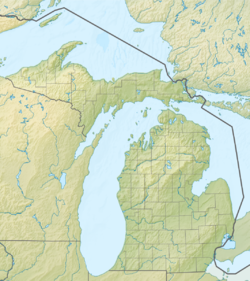
Back Detroit (rivier) Afrikaans نهر ديترويت Arabic نهر ديترويت ARZ دیترویت چایی AZB Дэтройт (рака) Byelorussian Детройт (река) Bulgarian ডেট্রয়েট নদী Bengali/Bangla Detroit (stêr) Breton Riu Detroit Catalan Detroit River (suba sa Kanada) CEB
| Detroit River Rivière Détroit | |
|---|---|
 Southern end as it enters Lake Erie with Canada in the foreground and the U.S. in the background | |
| Location | |
| Country | United States, Canada |
| State | Michigan |
| Province | Ontario |
| Cities | US: Grosse Pointe Park, Detroit, River Rouge, Ecorse, Wyandotte, Riverview, Trenton, Gibraltar Canada: Tecumseh, Windsor, La Salle, Amherstburg |
| Physical characteristics | |
| Source | Lake St. Clair |
| • coordinates | 42°21′07″N 82°55′03″W / 42.35194°N 82.91750°W |
| • elevation | 574 ft (175 m) |
| Mouth | Lake Erie |
• coordinates | 42°03′06″N 83°09′05″W / 42.05167°N 83.15139°W |
• elevation | 571 ft (174 m) |
| Length | 28 mi (45 km) |
| Basin size | 700 sq mi (1,800 km2) |
| Basin features | |
| Tributaries | |
| • left | Little River, River Canard |
| • right | River Rouge, Ecorse River |
| Islands | 31 (list of islands) |
The Detroit River is an international river in North America. The river, which forms part of the border between the U.S. state of Michigan and the Canadian province of Ontario, flows west and south for 24 nautical miles (44 km; 28 mi) from Lake St. Clair to Lake Erie as a strait in the Great Lakes system. The river divides the metropolitan areas of Detroit, Michigan, and Windsor, Ontario—an area collectively referred to as Detroit–Windsor. The Ambassador Bridge, the Detroit–Windsor Tunnel, and the Michigan Central Railway Tunnel connect the cities.
The river's English name comes from the French Rivière du Détroit (translated as "River of the Strait"). The Detroit River has served an important role in the history of Detroit and Windsor, and is one of the world's busiest waterways.[1] It is an important transportation route connecting Lake Michigan, Lake Huron, and Lake Superior to Lake Erie and eventually to Lake Ontario, the St. Lawrence Seaway and the Erie Canal. When Detroit underwent rapid industrialization at the turn of the 20th century, the Detroit River became notoriously polluted and toxic. Since the late 20th century, however, a vast restoration effort has been undertaken because of the river's ecological importance.
In the early 21st century, the river today has a wide variety of economic and recreational uses. There are numerous islands in the Detroit River, and much of the lower portion of the river is part of the Detroit River International Wildlife Refuge. The portion of the river in the city of Detroit has been organized into the Detroit International Riverfront and the William G. Milliken State Park and Harbor. The Detroit River is designated both an American Heritage River and a Canadian Heritage River—the only river to have this dual designation.[2][3]
- ^ Nolan, Jenny (February 11, 1997). "How the Detroit River shaped lives and history". The Detroit News. Archived from the original on July 10, 2012. Retrieved June 15, 2009.
- ^ Cite error: The named reference
AHRSwas invoked but never defined (see the help page). - ^ Cite error: The named reference
CHRSwas invoked but never defined (see the help page).

